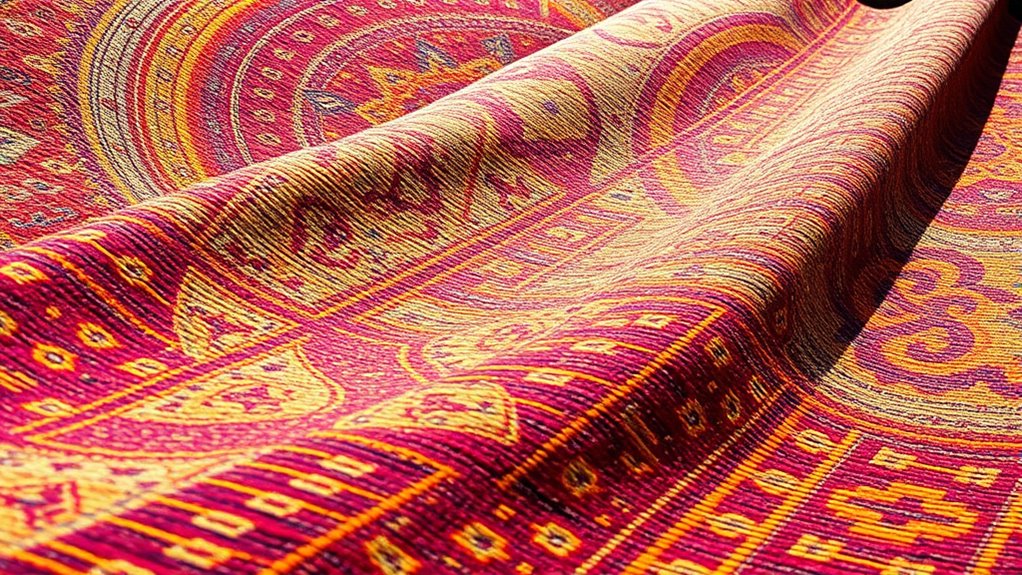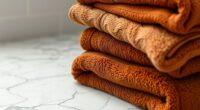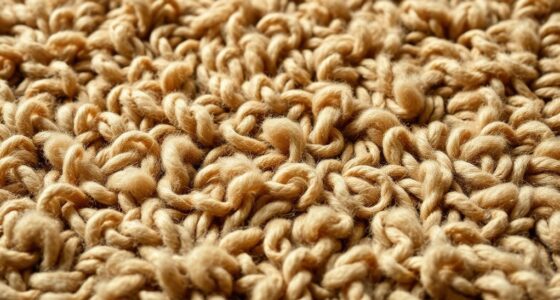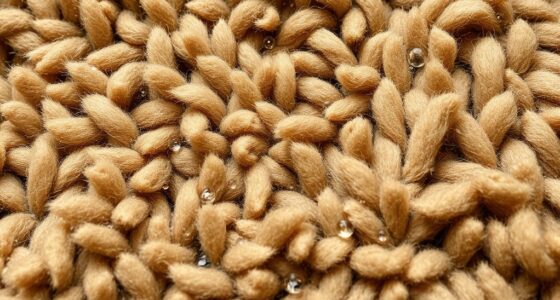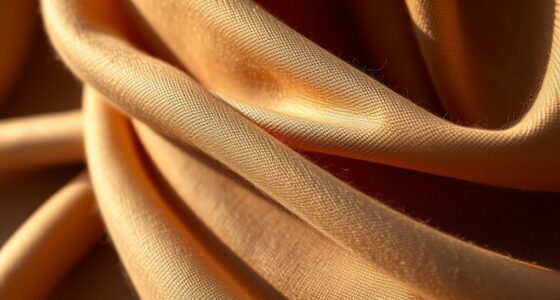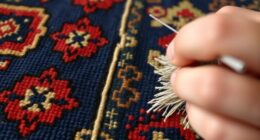Many believe that exposing vegetable-dyed carpets to sunlight causes quick fading, but that’s a myth. Natural dyes from plants can resist fading if exposure is managed well. Factors like the type of dye, fabric, and sunlight intensity really matter. Protecting your carpet with window coverings, rotating furniture, and careful cleaning can help maintain its color. Keep exploring—there’s more to learn about keeping your vintage or natural-dyed textiles vibrant over time.
Key Takeaways
- Properly protected vegetable-dyed carpets can resist fading despite sunlight exposure.
- UV light causes dye molecules to break down, but natural dyes can be more UV-resistant with proper care.
- Limited, indirect sun exposure minimizes fading, contradicting the myth that sunlight always damages natural dyes.
- Regular maintenance and protective measures extend the vibrant life of vegetable-dyed carpets under sunlight.
- Not all vegetable dyes fade quickly; stability depends on dye composition and environmental conditions.
Understanding Vegetable Dyes and Their Composition
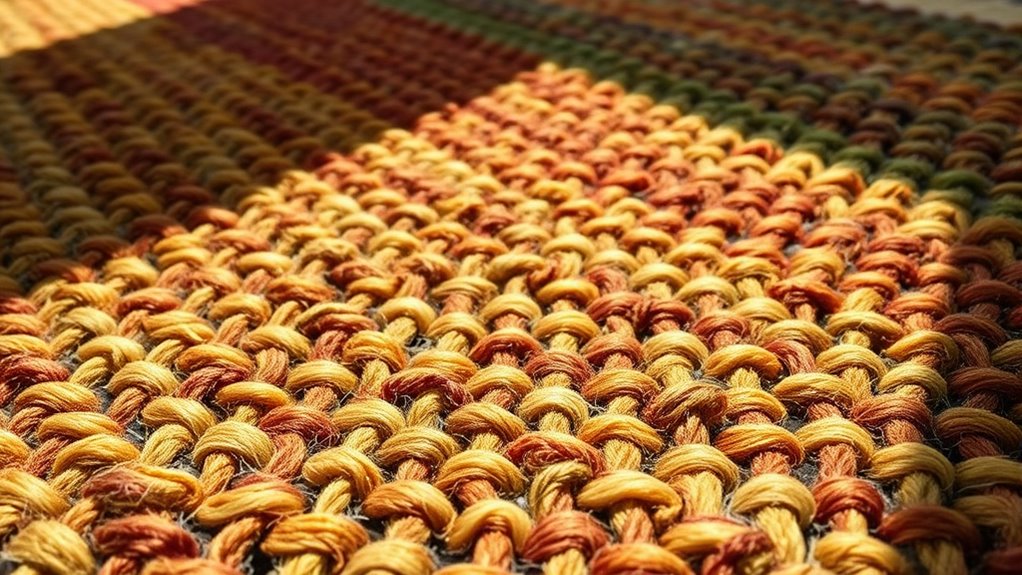
Vegetable dyes are natural colorants derived from plants, roots, berries, and other botanical sources. These dyes contain natural pigment molecules that bind to fibers, creating vibrant colors. Because they’re plant-based, they’re often considered environmentally friendly and non-toxic. However, dye stability varies depending on the plant source and processing methods. Some vegetable dyes are highly stable, resisting fading over time, while others may lose their vibrancy more quickly when exposed to sunlight. Understanding the composition of these dyes helps you appreciate their qualities and limitations. Their natural pigment offers unique, earthy tones that many seek for authenticity. Still, their sensitivity to environmental factors like UV light can impact color longevity, which is why knowing how vegetable dyes behave is essential for maintaining your textiles’ appearance. Additionally, the fiber type used in textiles can influence how well the dye adheres and resists fading over time. Moreover, UV exposure can accelerate the fading process, making it important to consider storage and display conditions for dyed textiles.
The Science Behind UV Light and Color Fading

Ultraviolet (UV) light from the sun causes molecules in dyes to break down, which leads to fading of colors over time. This process, known as photodegradation, occurs when UV photons are absorbed by dye molecules through their spectral absorption properties. When dyes absorb UV light, their chemical bonds weaken, causing the molecules to break apart or change structure. This breakdown alters the dye’s color, resulting in fading. The rate of photodegradation depends on the dye’s chemical stability and the intensity of UV exposure. Understanding this science helps explain why certain dyes fade faster than others under sunlight. While vegetable dyes are often thought to be more resistant, UV light actively triggers these photodegradation processes, gradually diminishing vibrant hues over prolonged periods of exposure.
Factors That Influence Sunlight’s Effect on Dyes
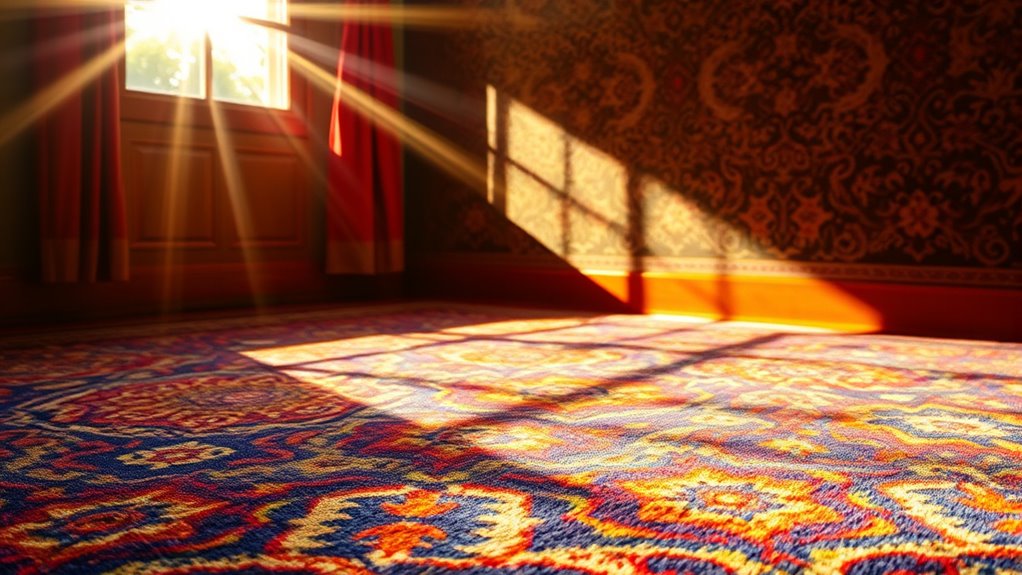
The way sunlight affects dyes varies based on several key factors. UV stability plays a crucial role; some vegetable dyes are naturally more resistant to UV rays, reducing fading over time. Light exposure, including intensity and duration, also impacts dye longevity—longer and harsher sunlight accelerates fading. The type of fabric or material influences how dyes respond to sunlight, as some surfaces absorb or reflect UV rays differently. Additionally, the dye’s chemical composition determines its resilience: dyes with strong chemical bonds tend to resist fading better. Environmental conditions like humidity and pollution can further weaken UV stability, making dyes more susceptible to deterioration. It is also important to consider the UV stability of vegetable dyes, as it directly affects their resistance to sunlight-induced fading. Research shows that certain treatments or protective coatings can enhance a dye’s UV resistance, extending the lifespan of dyed textiles. Moreover, understanding how material properties interact with UV exposure can help predict the longevity of vegetable-dyed carpets. Recognizing the dye formulation can guide you in choosing dyes with better natural UV protection, thereby prolonging their vibrancy. Understanding these factors helps you predict how sunlight will affect vegetable-dyed carpets and guides you in protecting them effectively.
Best Practices for Caring for Sunlit Vegetable-Dyed Carpets

Caring for sunlit vegetable-dyed carpets requires a proactive approach to preserve their vibrant colors. Limit direct sunlight exposure whenever possible, using window treatments like blinds or curtains to protect the carpet during peak hours. Regularly rotate furniture to prevent uneven fading and inspect for signs of color change. Keep the carpet clean by vacuuming frequently to remove dirt that can abrade fibers and diminish dye longevity. When cleaning spills, use gentle, pH-neutral cleaners to avoid damaging the dyes. Consider applying a protective sealant or UV-resistant coating designed for natural dyes, which can help shield the colors from sunlight. Additionally, understanding the role of attention in creative practice emphasizes that consistent care and focused effort are essential to maintaining the carpet’s beauty over time. Proper UV protection methods, such as using UV-blocking window films, can also greatly reduce fading caused by sunlight. It is also beneficial to monitor environmental conditions, ensuring that humidity and temperature levels remain stable to prevent fiber deterioration. To further safeguard your investment, avoid placing the carpet in areas with high UV light exposure, which accelerates fading and deterioration. By minimizing unnecessary sun exposure and maintaining proper care, you help ensure your vegetable-dyed carpet retains its beauty and prolongs its dye longevity over time.
Debunking Common Myths About Sun Exposure and Natural Dyes
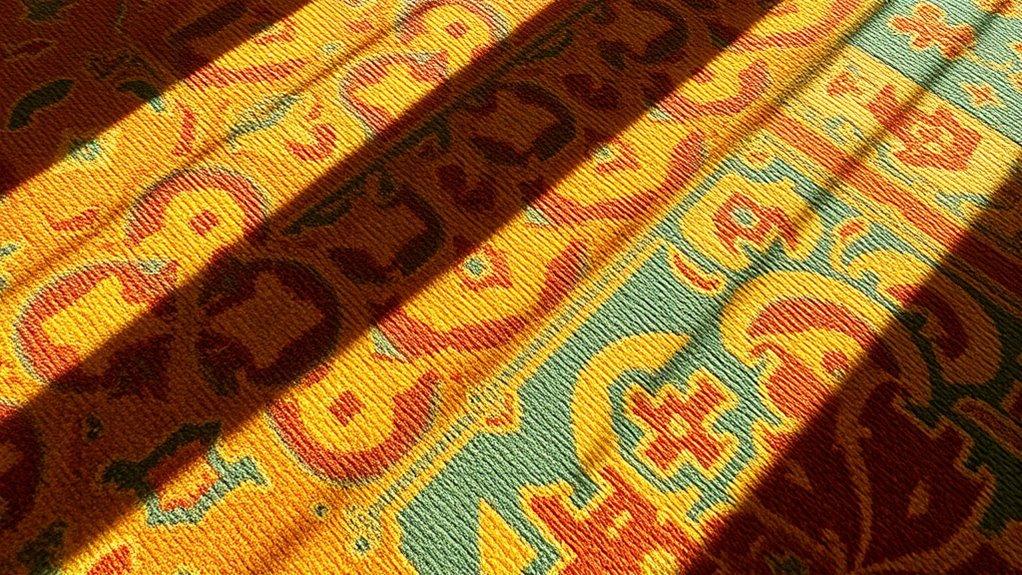
Many people believe that sunlight always causes significant fading of natural dyes, but this is a common misconception. While prolonged exposure can lead to sunlight degradation, it doesn’t mean your vegetable-dyed carpets will fade instantly or severely. Proper natural dye preservation depends on factors like dye type, fabric, and light intensity. Some natural dyes are more resistant to fading, especially when protected from direct, intense sunlight. You can enjoy sunlight in your space without fear, as long as you manage exposure wisely. Using window coverings or rotating your carpets helps minimize damage. Understanding that sunlight doesn’t inevitably ruin natural dyes allows you to balance light and preserve the beauty of your vegetable-dyed textiles. Additionally, light exposure factors such as duration and intensity play a crucial role in dye fading. With proper care, natural dyes can maintain their vibrancy over time, especially when understanding the light-fade resistance of different dyes and fabrics.
Frequently Asked Questions
Can Vegetable Dyes Be Completely Fade-Proof Under Sunlight?
You might wonder if vegetable dyes can be completely fade-proof under sunlight. While they’re natural and eco-friendly, exposure to UV rays can still cause fading over time. Synthetic alternatives and UV protective coatings can help preserve the vibrant colors longer, but no dye is entirely immune to sunlight. To keep your carpets looking fresh, limit direct sun exposure or apply protective treatments regularly.
How Long Do Vegetable-Dyed Carpets Typically Last in Direct Sunlight?
Imagine you’re in a vintage movie scene; sunlight exposure markedly impacts your vegetable-dyed carpet’s dye longevity. Typically, these carpets last about 1-3 years in direct sunlight, depending on the dye quality and exposure intensity. While vegetable dyes are more prone to fading than synthetic ones, proper care and limited sunlight can extend their vibrant life. So, if you want your carpet to last, avoid prolonged direct sunlight whenever possible.
Are There Specific Types of Vegetable Dyes More Resistant to UV Fading?
Some vegetable dyes are more resistant to UV fading than others, depending on dye composition and fiber compatibility. You’ll find that dyes derived from indigo or logwood tend to hold up better because their chemical makeup offers more stability against sunlight. When choosing a vegetable-dyed carpet, consider the dye’s composition and verify it’s compatible with the fiber type, as this combination can markedly influence how well it withstands UV exposure over time.
Does Carpet Thickness Influence the Rate of Uv-Induced Fading?
You might wonder if carpet thickness affects UV-induced fading. Thicker carpets with higher fiber density often have better dye penetration, making them more resistant to UV fading. The increased fiber density can protect dyes from sunlight exposure, reducing fading rates. Conversely, thinner carpets with lower fiber density allow UV rays to penetrate more easily, accelerating fading. So, consider fiber density and dye penetration when evaluating UV resistance in carpets.
What Are Innovative Treatments to Enhance UV Resistance in Vegetable Dyes?
While natural dyes offer beauty and authenticity, their UV resistance needs reinforcement. You can explore innovative treatments like natural dye stabilization, which helps maintain color vibrancy over time. Applying UV protective coatings provides a physical barrier against sunlight, markedly reducing fading. Combining these methods ensures your vegetable-dyed carpets withstand sun exposure longer, blending tradition with modern preservation techniques for vibrant, enduring color.
Conclusion
Understanding how vegetable dyes react to sunlight helps you care for your carpets better. Contrary to popular belief, only about 10% of natural dyes fade quickly under UV exposure if properly woven, so your vibrant, sunlit carpets can last for years. By following best practices, you keep their beauty intact. Don’t let myths scare you—embrace the natural charm of vegetable-dyed carpets and enjoy their timeless appeal in your sunlit spaces.
